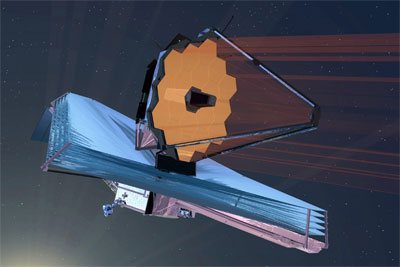Teaching space in US schoolsby Gary H. Kitmacher
|
| The standards recognize the importance of the new knowledge coming from and about space, the universe, and the Earth, and recognized the excitement and motivation that study of these new sciences can engender. |
Creation of a national curriculum in the US has been fraught with politics. Curriculum establishment has been a state and local governmental function, and while the federal government can spur initiatives towards the establishment of national standards, either through competitive programs such as “No Child Left Behind” or “ Race to the Top”, or through the publication of standards like the NGSS, it is still left up to the states to implement the curriculum and provide most of the resources that teachers and students require. A default national curriculum is effectively established through textbook adoption in the larger states, like California and Texas, where some 30 percent of the textbook market is controlled.3
Pre-empting the NGSS by several years, the Texas Education Agency (TEA) introduced new Texas Essential Knowledge and Skills (TEKS) requirements for K-12 ESS curricula in 2010.4 The TEA cited that this subject area could engage students, support science literacy, and support the development of 21st Century workforce skills; the state said it felt it was important to expand the curriculum. Across the state, 4.9 million students, 330,000 teachers, 9,200 schools, and more than a thousand school districts began to try and incorporate space education studies in the classroom. In the elementary and middle school grades, space was to be incorporated into composite science, while at the high school level new astronomy, earth, and space science courses were offered.
Where does space science end and astronomy or earth science begin? Space science is a study of issues related to space travel, space exploration, and scientific observations performed in space or from space.5 It is a new field of science begun only with the first flights into space in the 1940s and 1950s.6 As a course, it has not been a classic subject for K-12 education in most schools. There are related fields such as Earth science and astronomy, though neither of those have been a principal focus in pre-college education in the US for a century.7
The broad range of activities comprising space science allows a view into the activities of scientific research and engineering. Many regard space as an environment that opens opportunities for new experiences, spiritual enrichment, and jobs. The tools developed to study the distant universe have the potential for advancing education and science instruction.8
What is the scope of technology, history, or the arts that should be covered in space science topics? Are there appropriate textbooks or curriculum resources for the subject? The teachers surveyed in this study identified that these questions were issues in their teaching.
Between 2010 and 2013, I conducted a study that examined the instruction of ESS classes and curricula in the K-12 grade levels in Texas public schools. The study reflects responses to a survey sent to all Texas school districts and reflects responses from 326 teachers and an additional 25 interviews or class visitations which focused on three research questions:
- What are the characteristics of the population of teachers teaching space science associated subjects in Texas public schools?
- Do teachers feel they are able to teach the space science related subjects?
- What factors do teachers feel impede or enhance their ability to teach the space science associated subjects?
This essay reviews the highlights of the study findings. The teachers’ backgrounds, experience, and education are examined; the teachers identified the resources and community support they depend upon, and the challenges and difficulties that they face. Improvements that could help the teaching and learning of space science are recommended.9
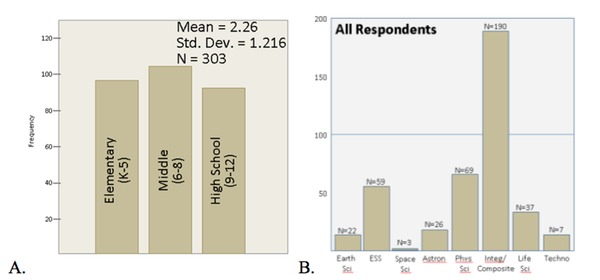 Figure 1. Grade levels of numbers of responding teachers (left) and numbers of responding teachers by subject (right) |
ESS is taught in most grades. ESS reaches essentially all students recurrently in most elementary and middle school grades as elements of an integrated or composite science curriculum. At the high school level, most ESS is taught to juniors and seniors as elective courses in astronomy or ESS. ESS was taught by 50%, and astronomy by 24%, of high school respondents. Most high school teachers also taught physical sciences (physics or chemistry). At all grade levels, space science teachers reported they were somewhat alone and isolated in their school and frequently in their district; often they were the sole ESS teacher.
Teacher experience
Sixty-three percent of the teachers had nine years or more of total teaching experience and 33% had 17 or more years of experience. However, most teachers had fewer than four years of experience teaching ESS or related areas. Elementary level teachers had the least experience. Figure 2 reflects the experience of the responding teachers.
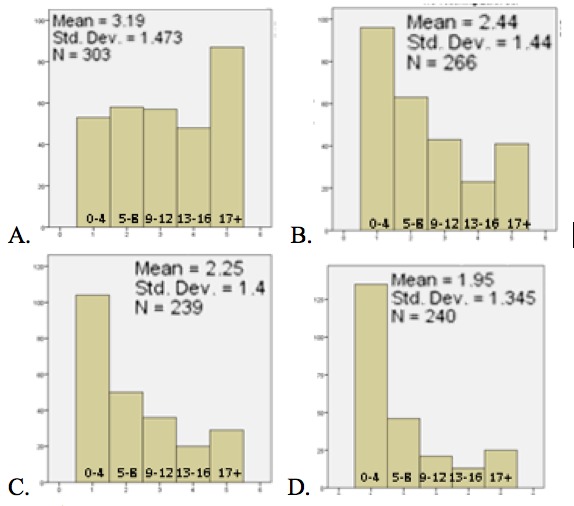 Figure 2. Experience. A. Total teaching experience in years, teachers teaching space science subjects B. Earth science teaching experience C. Space science teaching experience D. Astronomy teaching experience |
Teacher education
BS and MS degrees predominate over BA or MA degrees. Bachelor’s degrees predominate at the elementary and middle school grade levels; advanced degrees predominate amongst the high-school respondents. Most teachers, though, are teaching outside of their certification fields. At the elementary level very few teachers have any kind of a science degree. There are more science degrees at the middle and high school levels, though principally in life sciences rather than in majors related to ESS. Fewer than 10% of respondents have degrees in majors associated with ESS, such as geosciences or natural sciences. A significant number of the teachers identify never having any kind of training in areas associated with ESS. Many commented that their knowledge was limited. However, they felt the novelty of the information is important in capturing the students’ attention and they questioned how best to stay current in the ever-changing field of space science. The teachers said that they would welcome any professional development that was offered in ESS content or methodology. Figure 3 reflects the highest degrees attained, college majors, and most recent training for space science.
 Figure 3. Education. A. Highest degree earned. B. College majorsL A. Non-science. B. Life science. C. Physical science. D. Earth or space science degrees. C. Most recent space science training: A. Have never completed any. B. Professional development workshops within the last 5 years. C. College courses 7 years or longer ago. D. College courses in the last 4-6 years. E. College courses within the last 3 years. |
Space science curriculum establishment
Many teachers commented on the level of establishment of the curriculum. Some of the larger districts provide a scope and sequence of topics to be covered. However, many teachers indicated they had nothing more than the list of topic headings as cited in the top-level state requirements. Some teachers indicated that the subject headings were not particularly clear and that they have received little guidance in how to introduce or teach the subjects. Many teachers recommended better grade-to-grade continuity of the curricula and tying topics to particular grade levels. Figure 4 identifies the extent to which teachers recognized the definition of the curriculum for different subject areas.
 Figure 4. Perceived curriculum establishment on a 5 point scale from (1) least established to (5) most established in A. Earth science, B. Earth and space science, C. Space science, D. Astronomy |
Resources relied upon
The study sought to identify specific resources that teachers felt impeded or enhanced their ability to teach ESS. Most teachers report that their primary source of information and other resources used in teaching is the Internet. Most reported it is difficult to find the information they need in the time they have available for preparation. Dedicated preparation time was usually less than one hour a day, split between multiple course or study areas. Teachers said they needed a comprehensive set of readings, worksheets, and hands-on manipulable activities; a comprehensive set of classroom materials would also include discussion questions, interactive engagement activities, and assignments that would develop critical thinking skills while communicating information content. They report that they rarely have a set of such materials available for any individual space science topic.
Textbooks
| Most teachers reported it is difficult to find the information they need in the time they have available for preparation. |
For teachers who have little education in a subject, textbooks can provide the basis for the curriculum, the organization of the subject, and readings and activities for the students. About half of the teachers were using textbooks. A higher percentage had them for high school. However, many of the high school teachers reported using ten- to twenty-year-old textbooks from middle school astronomy classes, purchased when the subject was regularly taught in the lower grades years earlier. In elementary and middle school grades, teachers reported they did not need textbooks as ESS was only taught for at most several weeks. They said that online readings with complementary ancillary resources would be more useful.
Teachers said that their districts would not pay for textbooks for a subject that was changing rapidly and that was frequently not covered in standardized tests. Figure 5 reflects the proportions of teachers using textbooks and other written materials.
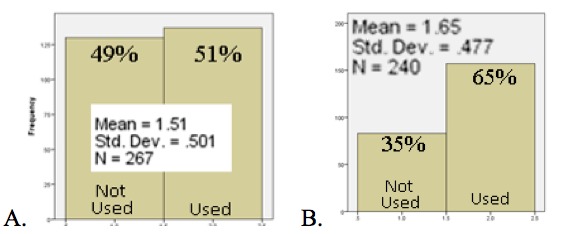 Figure 5. Resources: use of textbooks and other written materials. A. textbook use for all ESS subjects, all grade levels; B. use of written materials other than texts for ESS subjects, all grade levels. |
Computers
Teachers reported on the use of computers and the Internet. Ninety percent of teachers have a computer and projector in the classroom used for presentation. Far fewer—between 40 and 62%—have computers for student use in their classrooms and many of these are not used routinely or frequently. Many schools have limited numbers of computers for student use that teachers can schedule infrequently. Even less reliance was placed on computers outside of the classroom, where teachers expressed concerns about computer-based assignments because of limited access by the financially disadvantaged. Computer use was higher in the lower grades. Bar charts in Figure 6 reflect the use of computers by teachers and students, inside and outside of the classroom.
 Figure 6. Resources: use of computers for space science. A. use in classroom by teachers; B. use in classroom by students; C. use out of the classroom by teachers; D. use out of the classroom by students. |
Digital media and pre-recorded media
Use of digital media, which included tablets, apps, computer programs or DVDs, roughly corresponded to computer use, with fewer than 40% of teachers using them. Use of pre-recorded media, which could have included videotapes, DVDs, or Internet sources, was higher with 78% of the teachers reporting using them. Teachers were very dependent on the Internet for finding or developing content, but many teachers reported that Internet access in the classroom was sometimes problematic and depended on locality, school, technical and hardware restrictions. Figure 7 reflects the teachers’ reliance on digital and pre-recorded media.
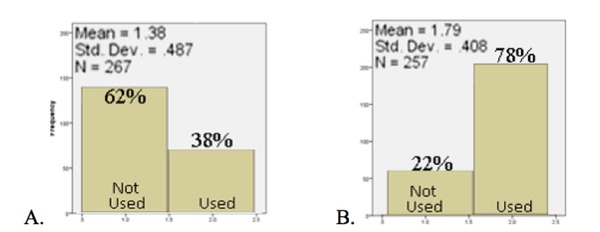 Figure 7. Resources: use of digital and pre-recorded media for ESS. A. digital media use, all grades, all ESS subjects B. pre-recorded media use, use all grades, all ESS subjects |
Community resources
Teachers ranked the degree of their dependence on a variety of community resources, including the Internet, school administration, teachers inside or outside of their own school districts, colleges and formal educational institutions, and museums and informal educational institutions. Most teachers reported that their primary source of information and other resources was the Internet. Figure 8 reflects the ratings teachers identified for dependence on different sources of community support.
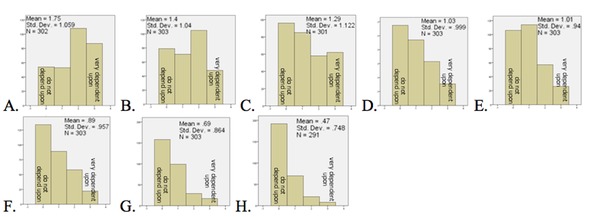 Figure 8. Resources. Teachers ranked the resources on which they depend for their ESS classes. These bar charts show the distribution of responses from most depended upon to least depended upon: A. Internet B. teachers within the district C. administration D. colleges and formal ed institutions E. museums and informal ed institutions F. teachers outside of the district G. subject matter experts in the community H. grants |
Factors in teachers’ ability
In order to assess whether the ability of teachers to teach space science was correlated with individual factors, four individual ability constructs were considered as dependent variables. Values identified for the curricula, resources, community support, and experience were treated as independent variables. In addition to the four individual ability factors, the four were also averaged and the average regressed against the independent variables. One-way analysis of variance (ANOVA) was used to analyze the correlation between the construct parameters of the independent variables (experience, education, community support, curriculum, and resources) with the dependent variable, ability. The correlations varied considerably between the different grade levels. The highly significant correlations are reflected in Figures 9 A-D.
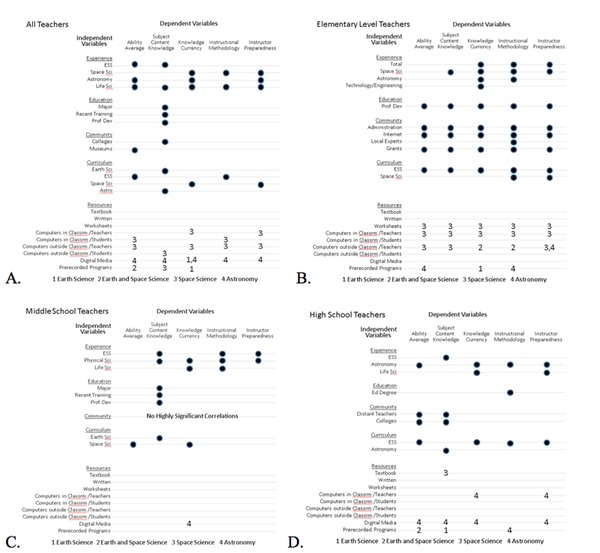 Figure 9. Highly significant (sig. < .01) correlations between each independent variable and dependent variable for A. the population of all teachers, and for individual populations of B. elementary, C. middle school and D. high school teachers. (larger version) |
Based on the regression correlations, the relative importance of different factors in order of predictive ability for teaching ESS are experience, curriculum definition, education, and community support. Community support is most important for space science and least important for earth science.
Recommendations
Most teachers said that a more cohesive and definitive curriculum is required. The level of curriculum detail covered in the Texas state requirements was inadequate for most teachers. Many felt that the curriculum as it had been defined was nothing more than topic titles. Establishment of a curriculum that covers all of the grades, ensures continuity between grades, and focuses on science and technology topics of particular interest would be helpful. The curriculum should introduce a subject in one grade and then come back to cover it in greater depth in subsequent grades.
| Providing a support network on which teachers could rely, including other teachers of similar content and subject matter experts from colleges, museums, industry, and government, would be helpful. |
Teachers are seeking professional development programs to become familiar with the curriculum subject areas and in order to maintain knowledge currency as the subject grows and evolves. The teachers need a better understanding of the specific topics to focus on and the tools and methods that can help to relate the meaning, wonder, scale, novelty, and significance of particular subjects to the students. While face-to-face professional development is preferred, several factors, including time, travel and accessibility, and costs, mean that online access would enable participation by more teachers.
In order to be able to teach the content with rigor and to develop the students’ critical thinking skills, teachers require comprehensive curriculum units or lessons for individual specific subjects and grade levels. Some suggested that these be incorporated into a project-based curriculum of readings, activities or laboratories, hands-on materials, and assessment tools. Curriculum units might be developed by subject matter experts in government or industry working together with curriculum developers and with support provided through appropriate distribution networks, including the US Department of Education and individual state education departments. Providing a support network on which teachers could rely, including other teachers of similar content and subject matter experts from colleges, museums, industry, and government, would be helpful.
Many teachers said that the timely availability of the most recent data and imagery from space and about space, and their integration into comprehensive lessons, is important. Many said that the curriculum materials would need to be provided at no expense. Distribution on the Internet is recommended. The curriculum units should be kept up to date and permit accessibility in a subject area that was not getting a fair share of the resources when competing against more established sciences. Internet distribution alone may be inadequate because, in many cases, restrictions on paper and printing services constraints the ability of teacher to distribute written materials to students.
References
1. National Research Council, (2012). Next generation science standards. Washington, D.C.: National Research Council. Retrieved from: http://www.nextgenscience.org/next-generation-science-standards
2. National Research Council, (2012). A framework for K-12 science education: Practices, crosscutting concepts, and core ideas. Washington, D.C.: National Research Council. Retrieved from: http://www.nap.edu/catalog.php?record_id=13165
3. Apple, M.W. The Politics of Official Knowledge: Does a National Curriculum Make Sense? The University of Wisconisin-Madison. Retrieved from: http://www.stanford.edu/class/educ232b/Apple.pdf
4. Texas Education Agency. (2010). Texas essential knowledge and skills for science. Retrieved from: http://ritter.tea.state.tx.us/rules/tac/chapter112/
5. Harra, L., & Mason, K. (2004). Space science. London, England: Imperial College Press.
6. Walter, W. (1992). Space age. New York. QED Communications.
7. Krunemaker, L. (2008). The status and make-up of the US high school astronomy course in the era of no child left behind. (Unpublished doctoral dissertation, University of Georgia). Retrieved from: http://athenaeum.libs.uga.edu/handle/10724/12725
8. Sellers, J. (2007). Understanding space: An introduction to astronautics. New York: McGraw Hill Companies, Inc.
9. Kitmacher, G. (2013). Teacher perceptions of factors that affect teaching space science in Texas. (Unpublished doctoral dissertation, University of Houston).
